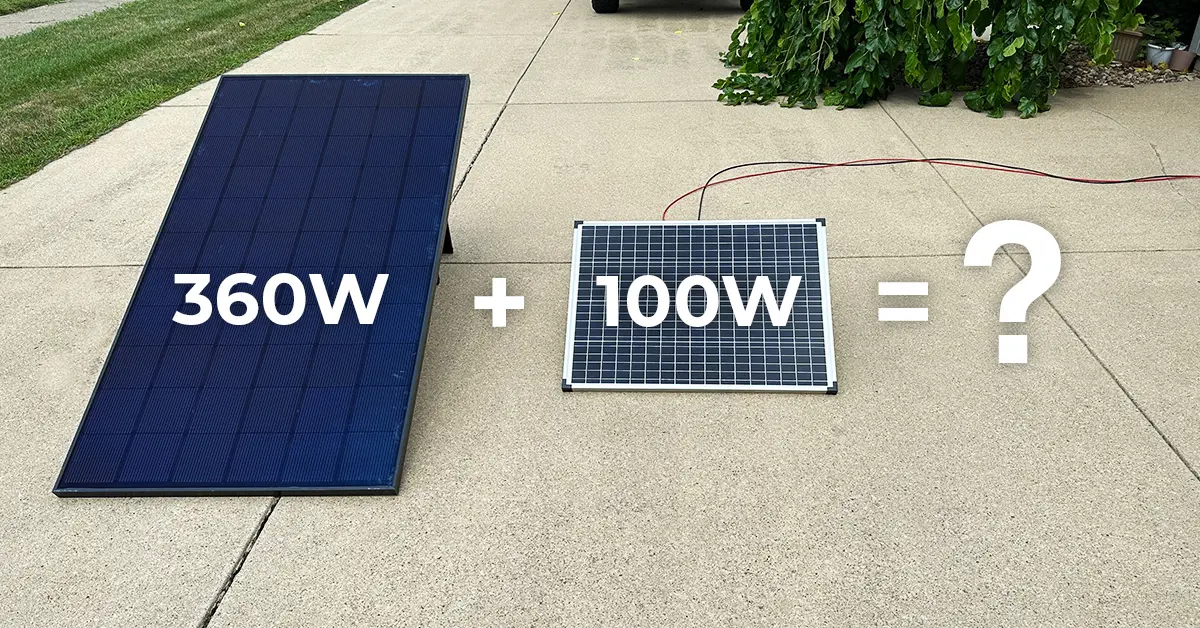Today, we’re tackling a common problem for solar users, especially those with RVs or trailers with limited roof space: how to combine mismatched solar panels to get the most power output.
Now, this isn’t as simple as plugging everything together in series and adding up the wattage—there’s more you need to consider.
So, let’s take a closer look at this puzzle using two mismatched solar panels—a 360-watt Heliene panel and a 100-watt Thunderbolt panel from Harbor Freight.
Rather watch than read? Check out this 8-minute video.
Assessing Individual Panel Output
Before we jump into combining these panels, let’s first check the power output of each one individually.
The 360-Watt Heliene Panel
Our trusty 360-watt Heliene panel is currently connected to the Ecoflow Delta Pro, and as of now, it’s producing around 250 watts. This equates to approximately 37-38 volts and about 7 amps.

The 100-Watt Thunderbolt Panel
Next up, we have the 100-watt Thunderbolt panel. Plugging this in, we see it’s generating about 74 watts, with a voltage of 16.5 volts and a current of 4.4 amps.

Setup 1: Mismatched Panels In Series
So, you might be tempted to try a simple solution—wiring these panels together in series.
After all, when you wire in series, you add up the voltages, right? Well, not quite. Let’s see what happens.
Actual Results of Wiring In Series
We’ll take the negative from the Thunderbolt and connect it to the positive of the Heliene; then connect the 2 remaining ends into the power analyzer and the EcoFlow Delta Pro

Surprisingly, our power analyzer shows that we’re now producing just under 250 watts.

This is interesting because when you look at the specifications of the Heliene panel at maximum power point, it’s rated at 360 watts under standard test conditions. So, what’s going on?
Understanding Our Result
Let’s do some quick math to understand our result for series wiring.

To calculate our expected voltage, we add up the voltages of each panel. In this case, we get 54.5 volts.
To calculate our expected power, we multiply voltage times current. However, since these are mismatched solar panels, we are limited by the lowest current, which is the Thunderbolt (4.4A).
So, wiring different-sized solar panels in series is not an ideal solution. But, what is a better way?
Setup 2: Mismatched Panels In Parallel
Let’s calculate our expected power with parallel wiring.

We’ll introduce another 100-watt panel and wire it in series with the existing Thunderbolt panel. Then, we’ll combine this setup in parallel with the 360-watt Heliene panel.
Here, we’re able to add up our currents, which is roughly 11.4 amps. So by multiplying our voltage (33V) and our current (11.4A) we’d expect to get 376 watts.
But what will this setup actually yield? Let’s find out.
Actual Results of Parallel Wiring
In this configuration, the two 100-watt panels are wired in series, which are then wired in parallel to the 360-watt Heliene panel through two branch connectors, which run back to the EcoFlow.

The power analyzer shows us the actual results of about 34-35 volts with over 12 amps and an output of over 420 watts. Not too shabby!

Conclusion
So, what did we learn from this experiment with mismatched panels? Here are the key takeaways:
- Voltage and Current Should Match
For efficient panel combinations, voltage and current should be as closely matched as possible. This helps maximize power output. - Avoid Series Wiring with Mismatched Panels
Wiring mismatched panels in series can lead to underperformance because you’ll be limited by the lowest current. - Consider Wiring in Parallel with Mismatched Panels
Parallel wiring allows you to add up currents and voltage, making it a better choice for different-sized panels. - Plan Your Solar System Carefully
If you’re still in the planning stage of your solar system, make sure to use specifications like voltage and current to estimate your panel’s performance realistically.
By understanding the principles of parallel wiring and using the right configuration, you can make the most out of your solar system, no matter the panel sizes.
This is a great DIY solar project, but if you’re looking for a larger system to offset your monthly power bill, SolarReviews is a great place to start. They will get you an estimate on the size and cost of solar for your home in a matter of minutes. Then, if you want to look into installers they can connect you with them as well.

